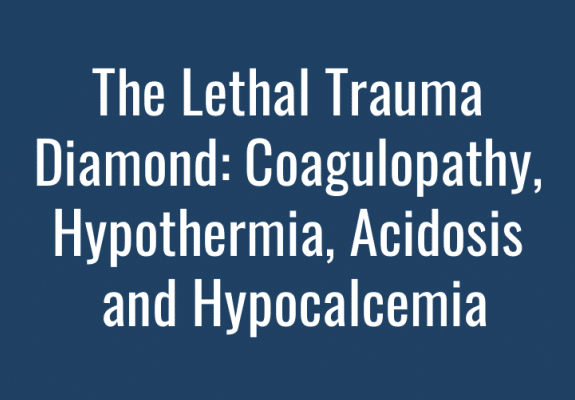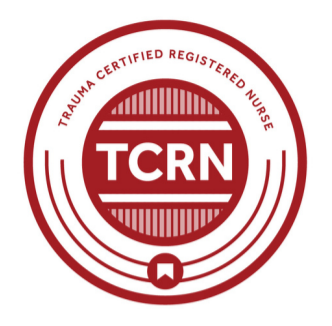
4 facts about the lethal trauma diamond that nurses should know – Trauma System News
The lethal trauma diamond is the “vicious cycle” of four physiologic derangements that can prolong blood loss, lead to hemorrhagic shock and increase the risk of death. The four points of the diamond are coagulopathy, acidosis and hypothermia (the traditional “lethal trauma triad”) and hypocalcemia.
Trauma and ED nurses should understand the causes and warning signs of the lethal trauma diamond and know how to mitigate the effects of each underlying condition.
1. Coagulopathy is present in about 30% of severely injured patients
Coagulopathy is the condition in which the blood’s ability to form clots is impaired.
Significant blood loss leads to coagulopathy because whole blood includes platelets and plasma, which are rich in clotting factors. In addition, injury and blood loss trigger the inflammatory response, which can lead to the rapid consumption of clotting factors. Further, resuscitation with excessive isotonic crystalloid solution (normal saline or lactated Ringer’s) can dilute already depleted clotting factors, which exacerbates coagulopathy. Finally, fluid volume overload can result in acute heart failure, which decreases the body’s ability to send clotting factors to areas of injury.
Other risk factors for coagulopathy include medication use (for example, warfarin or rivaroxaban), certain genetic conditions (for example, hemophilia), recent surgery, and recent pregnancy or late trimester pregnancy.
Interventions to mitigate the effects of coagulopathy include:
- Avoiding excessive fluid administration. As explained above, excessive isotonic crystalloid solution can exacerbate coagulopathy by diluting already diminished clotting factors.
- Early administration of blood products using a 1:1:1 ratio of red blood cells, platelets and plasma. Balanced resuscitation has been shown to improve hemostasis and reduce mortality.
- Early definitive hemorrhage control (damage control surgery).
2. Acidosis can be mitigated with interventions to correct the acid/base imbalance
Blood loss results in the loss of oxygen-carrying hemoglobin. This decreases cellular oxygenation, which results in anaerobic metabolism and the formation of lactic acid. The result is metabolic acidosis.
Metabolic acidosis and a low pH impair the production of thrombin and other clotting factors, exacerbating coagulopathy and leading to ongoing bleeding.
Interventions to mitigate the effects of acidosis include:
- Avoiding excessive fluid administration. Normal human blood is slightly alkaline, with an average pH of 7.40. In comparison, normal saline has a pH of 5.0 and lactated Ringer’s has a pH of 6.5. Consequently, the administration of excessive IV isotonic crystalloid solution in patients with significant blood loss can worsen acidosis.
- Obtaining early hemorrhage control. Early hemorrhage control and prevention of further blood loss can mitigate the effects of metabolic acidosis.
3. Hypothermia can be mitigated with interventions to promote normothermia
Hypothermia is defined as a core temperature less than 35° C (95° F).
Hypothermia impairs platelet function and inhibits thrombin production, which exacerbate coagulopathy. In addition, hypothermia slows down the metabolism of sodium citrate in the liver; unbound sodium citrate binds ionized calcium, decreasing calcium levels in the blood.
Interventions to mitigate the effects of hypothermia include:
- Using a warming infusion device to administer warm IV fluid and blood products.
- Increasing the temperature in the resuscitation room or operating room.
- Using warm blankets on the patient.
- Using a convective temperature management system.
- Using an intravascular temperature management system.
4. Hypocalcemia can be mitigated with interventions to normalize blood calcium levels
Hypocalcemia is the condition of low levels of ionized (free, unbound) calcium in the blood.
Severe blood loss as well as certain physiologic reactions to trauma (including tachycardia and sympathetic nervous system response) can lead to hypocalcemia. In addition, massive transfusion can worsen hypocalcemia. (Sodium citrate, which is added to banked blood products to prevent clotting, binds ionized calcium.)
Since calcium helps convert prothrombin to thrombin (a key part of blood clotting), hypocalcemia can exacerbate coagulopathy.
Interventions to mitigate the effects of hypocalcemia include:
- Early evaluation of baseline serum ionized calcium levels for patients who will be receiving blood products.
- Ongoing evaluation of calcium levels during MTP or multiple blood product administration.
- Evidence suggests that early administration of calcium products before and during transfusion is associated with increased serum ionized calcium levels on admission to the ED.
 Learn more about the lethal trauma diamond: This article is based on The Lethal Trauma Diamond: Coagulopathy, Hypothermia, Acidosis, and Hypocalcemia, an interactive online course from the Board of Certification for Emergency Nursing (BCEN®). Developed by nursing experts, this CE-eligible course helps nurses understand the damaging effects of coagulopathy, hypothermia, acidosis and hypocalcemia in the injured patient. To access this course and other learning opportunities for trauma nurses, visit BCEN Learn.
Learn more about the lethal trauma diamond: This article is based on The Lethal Trauma Diamond: Coagulopathy, Hypothermia, Acidosis, and Hypocalcemia, an interactive online course from the Board of Certification for Emergency Nursing (BCEN®). Developed by nursing experts, this CE-eligible course helps nurses understand the damaging effects of coagulopathy, hypothermia, acidosis and hypocalcemia in the injured patient. To access this course and other learning opportunities for trauma nurses, visit BCEN Learn.
 The Lethal Trauma Diamond supports the continuing education requirements of the Trauma Certified Registered Nurse (TCRN®) program. The TCRN credential is the only national board certification for trauma nursing, and it spans the body of knowledge for care of the injured patient. More than 7,000 nurses worldwide have earned the TCRN credential. For more information, click here.
The Lethal Trauma Diamond supports the continuing education requirements of the Trauma Certified Registered Nurse (TCRN®) program. The TCRN credential is the only national board certification for trauma nursing, and it spans the body of knowledge for care of the injured patient. More than 7,000 nurses worldwide have earned the TCRN credential. For more information, click here.



